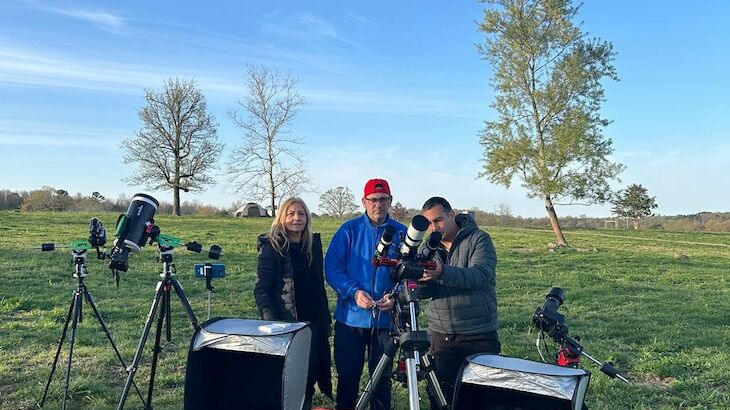Starlight Foundation present for the eclipse of the year
The Director of the Starlight Foundation travels to the United States as part of the National Eclipse Commission created by the National Commission of Astronomy to manage and organize the Spanish Great Eclipse.
2024 / 04 / 08

A solar eclipse is taking place today, Monday, April 8. It will be visible in totality in Mexico, the United States, and Canada, providing a brief moment when day turns momentarily to night.
The eclipse will be visible as a partial eclipse in North America, Central America, Iceland, the Azores, Madeira, the western United Kingdom, and very faintly in the extreme northwest of the Iberian Peninsula and the westernmost Canary Islands.
According to the National Astronomical Observatory, the maximum of the eclipse will occur at 18h 17m TU north of Nazas (Mexico).
This eclipse is special for several reasons. The first is that the shadow of totality will be twice as wide as that of the 2017 eclipse, making it more accessible to viewers in more locations. In addition, the duration of totality will be more than 4 minutes in many locations.
SCIENCE OF THE ECLIPSE
 Total Solar Eclispe/ Credit: Óscar Martín Mesonero
Total Solar Eclispe/ Credit: Óscar Martín Mesonero
This event occurs when the Moon lines up just right to come between the Sun and the Earth, blocking the Sun's disk and causing darkness similar to nighttime darkness.
Total solar eclipses occur about every year and a half. They occur in totality only in a narrow band over the surface of our planet. As soon as we move away from that band, even if it is very close, it will be observed in a partial way, making the event inconspicuous or even unnoticed. Only in the band of totality is the phenomenon overwhelming.
This type of event is also important at the research level because it is very useful for calculating the apparent brightness of the sky or for studying the outermost layer of the Sun's atmosphere, called the solar corona. This region can be observed without special instruments and will appear as a white glow around the disk when the moon blocks the sun's glare.
Starlight Foundation at the April 8th Eclipse
The director of the Starlight Foundation, Antonia Varela, who also holds a Ph.D. in Astrophysics from the IAC and is a member of the National Eclipse Commission (CNE), created by the National Astronomy Commission to manage and organize the Great Spanish Eclipse (the triple eclipse of 2026, 27 and 28), is currently in the United States to witness the totality of the solar eclipse.
In addition, during this trip, the director of the Museum of Science and the Cosmos of Tenerife, has also had the opportunity to visit the Space Center in Houston, where she has taken note of pieces and educational modules that can be useful for the Scientific Museum of Tenerife.
Varela comes with an expedition preceded by Oscar Martín Mesonero, veteran "eclipse hunter" of the Agrupación Astronómica de Salamanca, as well as a small group of experts from different Spanish autonomous communities.
The eclipse committee moved from San Antonio, Texas because of the weather forecast and is now near Little Rock, Arkansas after checking hundreds of locations. But they are keeping an eye on the weather in case they have to move again.
A total solar eclipse is an event that goes beyond scientific interest because, given its spectacular nature and "rarity," it can mobilize thousands of astrotourism enthusiasts worldwide.
The proper management of resources in the destinations where the totality of the eclipse will be seen, the safety of the amateurs and professionals who have come to see it, as well as the correct dissemination of the astronomical event, are key to these events.
As the world's leading promoter of star tourism, the Starlight Foundation is involved in this and other astronomical events to share experiences and learn from the management of each area.
Solar Eclipse April 8, 2024The Director of the Starlight Foundation with the group of eclipse "hunters", April 8, 2024.
Recall that the next total solar eclipse visible in Spain will take place on August 12, 2026, followed by another on August 2 of the following year. Shortly after that, on January 26, 2028, an annular eclipse will be visible.